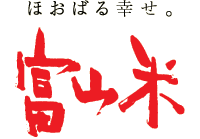収穫編

English
Since rice is the main staple of the Japanese diet, it is understandable that rice has deeply influenced Japan's food-culture.
日本語
お米は日本人の主食であるが故に、食文化にも大きな影響を及ぼしました。
Near the end of the Muromachi Period, for the first time since the foundation of the Japanese diet had been laid down, a wide variety of methods for preparing and enjoying rice-based cuisine had been created including Mochi (Rice cakes), Chimaki (Rice cakes wrapped in bamboo leaves), rice porridge and Kowameshi (Mochi rice with red beans).
室町後期に日本食の基盤が確立して以来、ご飯としてだけでなく、粥や強飯、餅、粽など、先人の様々な工夫によって多様な食べ方や加工法が生み出されました。
Also, Japanese Sake is made from rice.
また、日本酒もお米から作られたものです。
Not only is rice a facet of everyday life in Japan, it has also become the indispensable core of many traditional festivals.
お米は日常はもちろん、節目の行事などにも欠かせないものとなっています。
The easiest way to cook rice is to boil it. The following is an introduction on how to make deliciously fluffy rice.
お米を手軽に楽しむには、お米を炊くのが1番。ふっくら美味しいご飯に炊きあがる方法をご紹介します。
If you end up making too much rice, wrap the left-over amount while still hot, and store it in the freezer. Afterwards, you can simply defrost/heat the frozen rice in the microwave to enjoy rice which tastes as fresh as if it had just been cooked.
ご飯が残ったら、炊きたてのうちにラップに包んで冷凍保存しましょう。電子レンジで解凍・加熱すれば、炊きたてと変わらない美味しさを味わえます。
Accurately measure the amount of rice to be used. When measuring the amount of rice, be sure to use the measuring-cup which came with your rice-cooker. A typical amount of rice per serving is 180 cc (cubic-centimeters).
お米を正しく計る。
お米は、炊飯器に付属の計量カップで正確に計りましょう。一合は180ccです。
Quickly wash the rice. Using abundant water, rinse the rice in a mixing-motion, draining the water completely when finished. Repeat this process 2 or 3 times. The point here is to wash the rice gently, in order to prevent the loss of nutrients or the glutinous-flavor.
手早くお米を洗う。
たっぷりの水で、軽く混ぜるようにして手早く洗い、すぐ水を捨てます。あとは2~3回水を替えて洗います。糠の旨みや栄養を損なわないよう、やさしく洗うのがポイントです。
Accurate adjustment of the amount of water used when cooking. In the case of Japanese rice, a general rule of thumb for the amount of water used is to add 1.2 times the amount of unwashed-rice. Depending on whether you want softer rice or harder rice, feel free to adjust the amount of water accordingly.
水加減も正確に。
普通水加減は、の白米の場合、洗う前のお米の容量の1.2倍が一般的です。やわらかめ、硬めなど好みにあわせて、水を調整しましょう。
Pre-soak the rice in water. Remember to pre-soak the rice in water for 30 minutes in the summer, and 2 hours in the winter. The secret to cooking fluffy rice is to the make sure the rice absorbs the proper amount of water before cooking.
お米を水に浸す。
夏なら約30分、冬なら約2時間は水に浸しましょう。お米に水を吸わせることが、ふっくらとしたご飯を炊くコツです。
Slowly let the rice steam after turning off the heat. Turn on the rice-cooker and let it work. Once the cooking cycle is complete, let the steam in the rice-cooker naturally finish the cooking process for about 10~15 minutes. Be sure not to open the lid during the cooking process. Letting the rice steam naturally ensures that each grain of rice is consistently moist.
じっくり蒸らす。
炊飯器のスイッチを入れて炊きます。炊きあがったら、そのまま10~15分程おいて、蒸らしてください。途中でフタを開けることは禁物。じっくり蒸らすことで、ご飯粒の水分が均一になります。
Stir the rice. Slowly stirring the rice in a large, gentle motion from the bottom of the container, ensures that you get the most deliciously fluffy rice every single time!
ご飯をほぐす。
しゃもじで底からご飯粒をつぶさないように大きく混ぜれば、ふっくらとした美味しいご飯の出来上がり!
田植え編

English
The main staple of the Japanese diet is rice – a hard kernel of the rice-plant.
The rice-plant is cultivated in a rice-paddy (i.e. a field filled with water), giving rise to the name, "wet-land rice."
日本語
日本人の主食であるお米は、稲の種実です。
その稲は水田(水をたたえた田んぼ)で栽培されることから、水稲と呼ばれています。
Although rice-plants can be grown by planting seeds in a dry-field, cultivation in a rice-paddy produces higher quality and volume, which gave rise to the tradition of wet-land rice.
稲は畑の上に種をまいて育てる方法もありますが、水田で育てた方が品質が高く収穫量が多いため、昔から水田で栽培されています。
This process is called rice-cultivation, and its roots can be traced back to the Jomon period, spreading across all of Japan during the Yayoi period.
この栽培のことを稲作といい、その始まりは縄文時代にまでさかのぼり、弥生時代に日本全国に広まったといわれています。
The Japanese environment wasn't always suited for rice-cultivation. It is thanks to the tireless efforts of the early pioneers of Japan that rice-cultivation became possible.
日本はもともと稲作に適した風土だったわけではありません。先人の知恵や努力によって根付いたとされています。
According to the latest techniques, rice-plant sprouts, which have been partially raised in a seedling-incubator or hot-house, are planted in a rice-paddy using a rice-planting-machine.
Periodically, weeds are removed and fertilizer and pesticides are sprayed.
When the rice-plants are fully ripe, a combine is used to harvest the plants and separate the rice kernels from the chaff.
最近の一般的な方法は、育苗箱やビニールハウスである程度大きく育てた稲の種・種籾(たねもみ)を田植え機で田んぼに植え、定期的に雑草取り・農薬散布・肥料散布等を行い、稲が実ったらコンバインで稲刈りと脱穀を行うという方法です。
One of the advantages of rice-paddy cultivation is that, unlike dry-land cultivation, the same plot of land can be used multiple times in succession for rice-cultivation, with a lower risk of lowering the fertility of the soil through repeated usage.
稲作の利点としては、他の畑作に比べ、同じ田んぼで同じ作物を何度も繰り返し栽培する「連作」によって、次第に生育不良となる「栽培障害」になりにくいという面もあります。
The image of rice-cultivation is one which permeates every aspect of Japanese life, symbolizing Japan's rich traditional-culture.
稲作の光景は、日本の伝統文化のひとつであり、日本人の暮らしに深く浸透しています。
Something which expresses this relationship is the "Yo-Shuku-Gi-Rei": a traditional prayer-ceremony held before cultivation begins, wishing for a bountiful harvest.
その関わりを示すのが、耕作開始に先立ち、その年の豊作を祈って行われる前祝いの行事「予祝儀礼」。
A wide variety of festivals have been passed down through the generations. Examples include "Ta-Uchi-Shou-Gatsu", a festivity re-enacting the task of rice-planting, and "Ta-Asobi", a ceremony re-enacting daily-life on a farm.
田植えを真似る「田打ち正月」や、農作業を模擬的に演じる「田遊び」など、様々な行事が受け継がれています。


